
Wakker Dier: animal rights activism in the Netherlands
This article presents a case study of the online mediatization of offline animal rights activism. Specifically, it discusses the campaign of Dutch organization Wakker Dier, which went viral on Facebook.
Wakker Dier: the organization
Wakker Dier (Dutch for "Awake Animal") is a Dutch non-profit organization that tries to improve the miserable conditions under which many animals live, often succeeding in its efforts. For example, thanks to their campaigns, the consumption of foie gras has lost a lot of its popularity over the years. Even though the effects of their campaigns and actions are not always as definitive or measurable, Wakker Dier has been in the public eye many times.
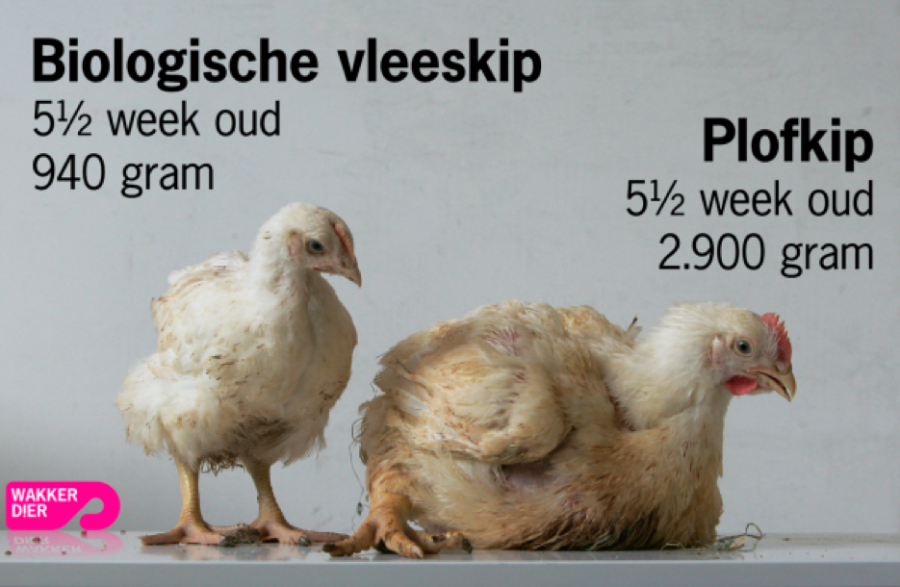
Figure 1. A stereotypical Wakker Dier message that compares the biological broiler chicken with the “plof chicken” (a term for common broiler chickens that barely meet the European minimum legal standards)
Wakker Dier is not only known for serious and controversial activism. They are also well-known for “soft activism,” which involves, for example, the development and distribution of animal-friendly recipes. The organization is also notorious for its annual “Liegebeestverkiezingen” ("Liar’s elections"), in which Wakker Dier nominates and elects the most unfair or misleading animal advertisements. The winner of these elections is then crowned Liar of the Year.
"An animal-worthy life for all animals in livestock farming: that is our dream."
Wakker Dier’s mission is formulated as follows: “An animal-worthy life for all animals in livestock farming: that is our dream. An animal is not a lifeless product, but the food industry thinks otherwise. In this sector, animals serve only one purpose: to make profit. However, producing meat, eggs, and dairy products as cheaply and massively as possible, causes a great deal of animal suffering.” Here, we pick up the organization’s ideology, in which drastic reformation of the food industry and general improvement of animal well-being are central ideas.
According to Wakker Dier, we must both reduce and improve the meat supply: “In 2030, meat consumption in the Netherlands should be reduced by a quarter, and all meats should have at least one “Better Life” star.” This star refers to a kind of quality label for meat, poultry, and eggs. It was launched by the Animal Protection services in 2007. In the case of chickens, for example, one star means on their packaging indicates that no more than twelve chickens were kept per square meter.
A real social movement
What started in 1997 as a small foundation has grown into a real social movement. Wakker Dier is an influential party in the discursive battle for meaning/hegemony, constantly making its mark in national politics. Their data are often used by the Party for the Animals and their investigations regularly appear on national news. And with success: the sale of products with animal welfare labels is increasing rapidly in the Netherlands. In fact, Wakker Dier is often feared by the food industry and many Dutch supermarkets.
Another interesting fact about the organization is that over 83% of the organization’s benefits comes from donors, and they have around 25,500 of them, which is a lot considering the country’s small population. This goes to show that Wakker Dier has quite a large following with many actively involved in the organization with donations.
Online and offline activism
It is hard for any activist movement to survive if it does not engage in both offline and online activism, which is why we often encounter a mix or a combination of the two, sometimes even simultaneously. A nice example of this mix is Wakker Dier’s yearly Facebook event on Animal’s Day (October 4), called “Eet Geen Dierendag” ("Don't Eat Animal’s Day"). In 2019, more than 5,500 people were “interested” in this event and more than 8,800 people “went” to it although there was no actual physical gathering; it is a symbolic event.
Lots of people share vegetarian or vegan recipes on such Facebook events (see Figure 2). Though the event is purely online, many people actually change their behavior in real life and post about not eating any meat that day. Some simply continue following their animal-friendly diets (like the person in Figure 2, who was already a vegetarian), but others really change their diets in response to the event. In other words, the online-offline nexus, representing how online and offline life are intertwined, becomes clearly visible (Blommaert & Varis, 2015; Maly, 2019).
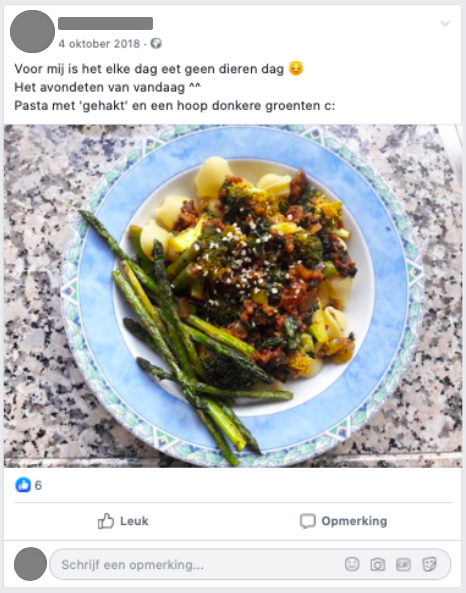
Figure 2. Someone sharing an animal-friendly recipe on the “Don't Eat Animal’s Day” Facebook page.
A more recent example and also the main topic of this article involves the online mediatization of the organization’s offline activism. On September 18, 2019, Dutch supermarket Albert Heijn was elected Liar of the Year by Wakker Dier, with over 7,000 out of 19,000 total votes (Figure 3). Albert Heijn owed its nomination to the packaging of its private label chicken. This packaging says “more space” even though the supermarket gives their chickens the least amount of space out of all Dutch supermarkets: sixteen chickens per square meter.

Figure 3. The AH chicken (which was introduced as an “in between chicken” after the plof chicken was banned from all Dutch supermarkets in 2016) winning the Liar of the Year elections.
Chasing delivery trucks
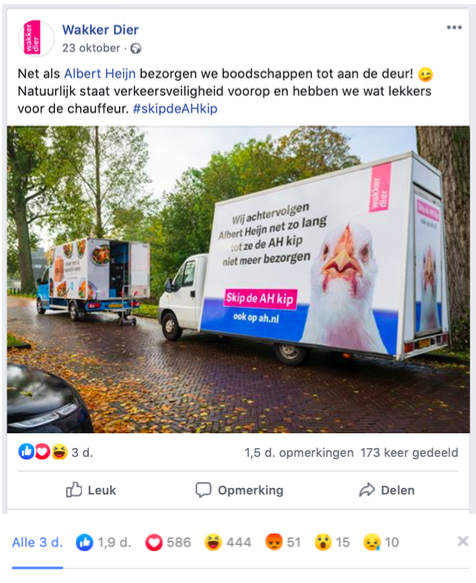
Figure 4. The Facebook post announcing Wakker Dier’s actions and its uptake. Screenshots taken on January 13, 2020.
About a month later, on October 23, Wakker Dier announced on all their social media that they were going to follow home delivery trucks from Albert Heijn with a truck of their own. This truck displayed a large text on its sides, saying: “We are chasing Albert Heijn until they no longer deliver the AH chicken.” The announcing post on Facebook reached quite an audience: it got around 3,000 reactions, over 1,500 comments, and 173 shares (Figure 4). To illustrate, the usual uptake of Wakker Dier’s Facebook posts is somewhere between 100 and 1,000 likes.
"We are chasing Albert Heijn until they no longer deliver the AH chicken."
Wakker Dier generally deals with a lot of negative attention; there is even an Anti Wakker Dier Facebook page which is particularly popular among farmers. However, keeping in mind that not all reactions are positive, this uptake is quite spectacular, especially by Dutch standards. So, how did Wakker Dier manage to go viral with this specific campaign? That is the question this article aims to answer. Did the organization “manage” the uptake through algorithmic activism? Or was their strategy based on structurally normalizing ideas and discourse over time?
A digital ethnographic approach
Contemporary digital activism is not only about producing discourse in the passive sense (Maly, 2019, p. 2). It is also about producing discourse actively, which involves really managing and organizing uptake, and making absolutely sure that certain ideas will circulate and will reach new audiences. In order for algorithms to push posts into relevance, they must reach people that actively support or at least interact with them (Maly, 2018, p. 9). Relevance here is measured in terms of uptake (e.g. number of shares). Making sure that certain messages will interact with each other can be done by, for example, using bot networks or message groups.
The analysis in this article rests upon a digital ethnographic approach. It analyzes naturalistic data and focuses is on what is naturally visible. The dataset therefore consists of first-hand screenshots of Wakker Dier’s Facebook posts, their corresponding uptake in terms of likes, comments, and shares, and real Facebook comments. Not only does the language used matter, so do the metrics involved (e.g. number of likes). Also, attention will be paid to the temporal sequence of Facebook posts, in order to examine whether a meaningful pattern emerges whereby ideas and discourse circulate over time, possibly leading to normalization. All screenshots were taken by the researcher.
The start of the campaign
The people who wrote the Facebook post announcing Wakker Dier’s campaign on October 23 are clearly familiar with the medium’s affordances. The post contains a hyperlink to the Facebook page of Albert Heijn (AH), directly addressing the corporation. It also contains a hashtag: #skipdeAHkip ("skip the AH chicken"). The text reads: “Just like Albert Heijn, we deliver messages/groceries right to the door! ;) Of course, safety in traffic comes first and we have some goodies for the driver #skiptheAHchicken.” The Dutch word “boodschappen” can mean either “groceries” or “messages,” which gives the post a double meaning.
On the first day of their campaign (October 25), Wakker Dier posted a short video in which they chased one of the supermarket’s trucks. In it, we see a fully loaded delivery truck driving away from an Albert Heijn supermarket early in the morning. It is almost immediately followed by Wakker Dier’s truck, which looks similar apart from the fact that it displays a huge text and a picture of a very upset chicken. The video follows the two vehicles over the highways and through different neighborhoods, until the trucks return to the supermarket at sundown. The funny background music, which starts the moment the second truck appears in the video, gives it a mocking undertone.
Uptake of the video
The Facebook post containing the video did extremely well in terms of uptake (Figure 5). It has over 16,000 views, almost 1,000 likes, more than 800 comments, and 67 shares. The text says: “Do you also think Albert Heijn should skip the AH chicken? #skiptheAHchicken #dontworrywearenicetothedriver #andwecompensateco2.”
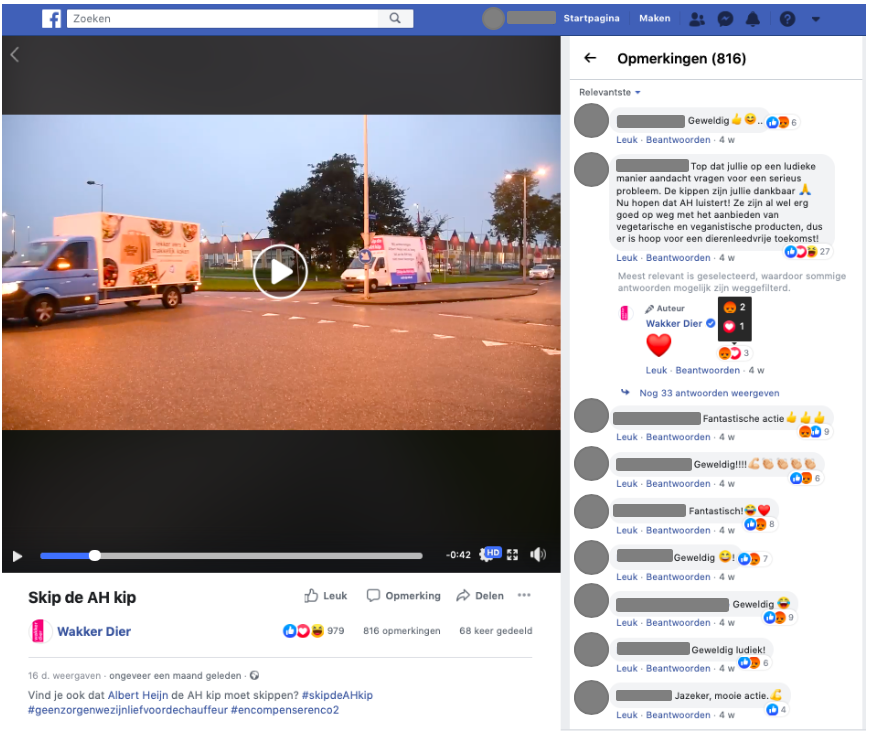
Figure 5. Reactions to Wakker Dier’s Facebook video of them chasing an Albert Heijn delivery truck. Screenshot taken on November 25, 2019.
Again, the people who made the post seem to be familiar with the medium's affordances: the post contains a question and several hashtags, giving us reason to believe the post was designed for uptake. The most liked comment (with 27 likes and 34 sub-comments) remarks: “Great that you draw attention to a serious problem in a playful way. The chickens are grateful. Let’s hope that AH is listening! They are already well on their way with offering vegetarian and vegan products, so there is hope for a future without animal suffering!”
"There is hope for a future without animal suffering!"
Another thing that stands out is that many of the comments have received “angry” reactions as well. When looking at the profiles of these angry commenters, we see that most appear to be individuals who are prototypically anti-Wakker Dier, such as farmers and/or meat lovers. Nevertheless, the angry commenters played quite a large role in the process of the post going viral. After all, they too helped with pushing the message forward, enabling it to ultimately reach a larger audience.
Compared to the usual uptake of Wakker Dier’s Facebook posts, the number of likes, comments, and shares is quite high here. We cannot really compare the number of views as the organization generally does not post many videos and because some videos are highlighted on the organization’s home page while others are not.
If we look at the first twenty profiles that shared the video, all of them seem to belong to real individuals. They all have profile pictures of regular people who work in the Netherlands an/or (have) follow(ed) some education. From what is visible, they all have a reasonable number of friends. When scrolling through their timelines, all these profiles show a history of sharing posts that concern animal welfare, environmental issues, and/or specific animals that are up for adoption. A small number of friends usually comment on these posts.
These people seem to differ in terms of their involvement in activism: some of them only share posts, but others also actively participate in offline activism and post about their experiences online. Figure 6 shows some examples of both practices. All in all, these profiles give us no reason to believe that the Wakker Dier post's uptake was managed or constructed algorithmically. We see no indicators of any message groups, unusual or foreign profiles, or larger platforms that might push messages forward.
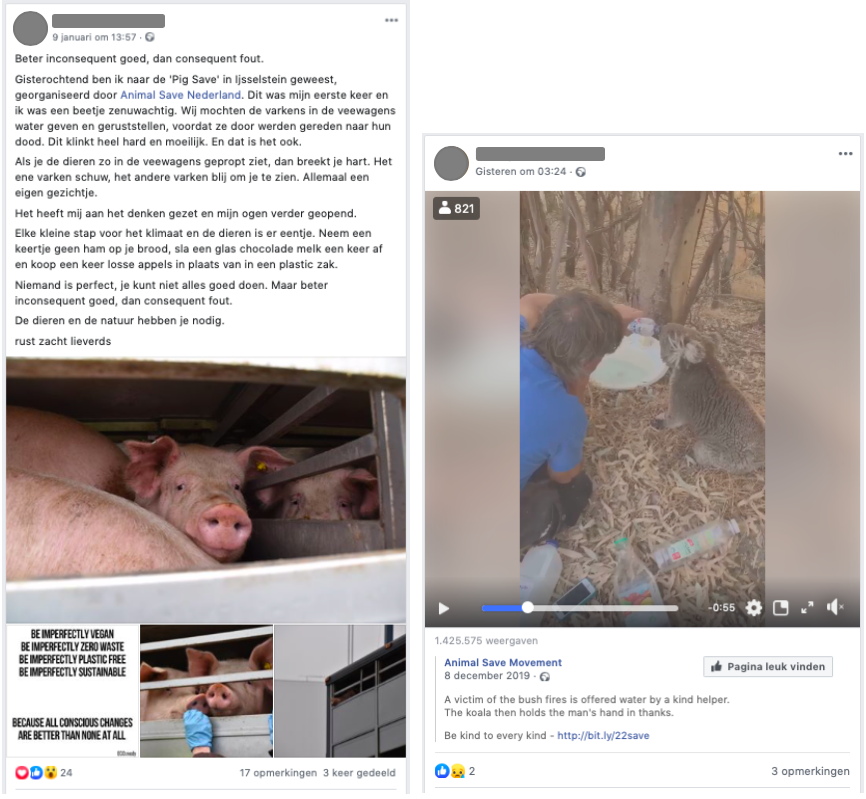
Figure 6. Two Facebook posts from profiles that also shared Wakker Dier’s campaign video. They are about participation in offline animal activism and Australia’s wildfires. Screenshots taken on January 14, 2020.
The ten “most relevant” comments also seem to come from real people whose Facebook timelines are filled with photos of pets and videos of funny animals. On one profile, we see a banner that says: “The future is vegan!” As is always the case with posts by Wakker Dier, some commenters are angry with the organization and state that their actions are a waste of time. On the individual profiles of these commenters, we again see no signs of algorithmic activism.
Normalizing their ideology
If we look at Wakker Dier’s strategy on a much larger scale, however, something does stand out. It seems as though Wakker Dier had earlier plans to “attack” supermarket Albert Heijn. It all began with a video that was launched on July 29, 2019. In this short but striking video, we hear a voice-over saying: “Supermarket Albert Heijn does not care much about the living conditions of its chicken. The AH chicken lives in a crowded stall with sixteen chickens per square meter. That is not what we call a life. Don’t take it any longer and skip that AH chicken.”
On Facebook, the video did extremely well: over 56,000 views, 646 comments, and an astonishing 536 shares. The reason as to why this particular video went viral probably has to do with the fact that the video appeared - and still appears - on Dutch national television every single night. In today's hybrid media system, it is important for organizations to be active on multiple platforms, media, and modalities (Chadwick, Dennis, & Smith, 2016).
This is also why Wakker Dier’s campaigns always appear on many different media, both online and offline (e.g. on television and on supply-and-demand boards in supermarkets). Television is a handy medium because it reaches an enormous number of people every single day. An appearance on television may increase the chance of one's message being picked up by the news, which may in turn help it reach a larger audience. Either way, it may be that the campaign did not actually start on October 25, but on the day this short video was released, i.e. on July 29.
A timeline of normalization
In fact, the 25-second video appears to be the initiator of a chain of (Facebook) posts and (offline) actions, cleverly spread out over several months and concerning the same topic. In an overview, the following timeline becomes visible:
- 29 July 2019. The “skip the AH chicken” campaign airs on national television and radio. In a short video, which went viral on Facebook, Wakker Dier urges everyone to let the supermarket know they skipped the AH chicken.
- 16 August 2019. 26,000 people let the supermarket know they skipped the AH chicken.
- 26 August 2019. Wakker Dier announces the nominees for the Liar's elections. People can start voting.
- 27 August 2019. Wakker Dier sprays “skip the AH chicken” graffiti templates on the floors of multiple Albert Heijn entrances.
- 18 September 2019. Albert Heijn is elected Liar of the Year because they state that the AH chicken has “more space.”
- 4 October 2019. The Don't Eat Animal’s Day campaign reaches 500,000 employees. 2,000 company restaurants serve only vegetarian lunches.
- 23 October 2019. Wakker Dier announces on all social media that they are going to chase Albert Heijn home delivery trucks until the supermarket stops delivering the AH chicken.
- 25 October 2019. Wakker Dier posts the video of their truck following Albert Heijn home delivery trucks on all social media.
- 6 November 2019. People can order pink cards saying: “I am skipping the AH chicken” for free on Wakker Dier’s website. Albert Heijn customers are urged to leave them on the supply and demand boards inside supermarkets.
Wakker Dier continues to spread both positive and negative messages concerning the bigger picture of the campaign:
- 25 November 2019. “Good news! All chicken meat products from supermarkets Coop, Dirk, and DekaMarkt have at least one star. That means that the chickens get more space, fresh outside air, and daylight. Don't you wish that for every chicken?"
- 3 December 2019. "On our way to private label chicken with at least one Better Life star, Albert Heijn is still behind: the multinational has 20% more chickens per square meter than supermarket Jumbo. Come on Appie, give the AH chicken more space.”
In 2020, Wakker Dier suggested some new year’s resolutions for Albert Heijn (January 1) and reiterated the fact that the supermarket had not done the right thing despite the truck chase (January 6). When looking at this temporal sequence of events, posts, and actions, we can tell that Wakker Dier uses both positive and negative (but mostly negative) messages to attack the corporate image of Albert Heijn.
The process of creating this negative image did not go unnoticed by mainstream media. News platforms steer information flows, and many media outlets actually put out more negative messages for the supermarket. By reporting on it, they generated potential economic damage for Albert Heijn. And though some really large platforms (e.g. Hart van Nederland) stated that Wakker Dier had gone too far, they all helped with spreading the message to a larger audience. During this process, Wakker Dier really managed - and still manages - to stay “on message” while consistently constructing and reinforcing its own image and identity (Silverstein, 2011).
This identity is characterized by certain discursive styles, such as the consistent use of certain colors (e.g. pink and blue) and catchphrases (e.g. #skiptheAHchicken). It is also accompanied by a clear and transparent ideology, which enables us to “fill in the blanks” in certain situations. We are thus getting a picture of what Wakker Dier really stands for and how they would respond to different social issues, whether real or fictional. This “imaginary response” is essentially what message is all about. As Silverstein (2003, p. 16) put it: “A really powerful message allows for an audience to imagine a whole set of plausible stories in the fictive universes of the must-have-been, the could-be, and the sure-as-hell-will-be.”
Normalizing discourse over time
So, how did Wakker Dier manage to go viral with this specific campaign? From the looks of it, the organization has no message groups, no bot networks, and no other online constructions that push their Facebook posts forward and into relevance. So, Wakker Dier probably did not “manage” a substantial part of the uptake of their posts through algorithmic activism. Profiles that shared and commented on the posts seem to come from real people who just happen to care a lot about animals. What we do see then, is organic uptake from followers of Wakker Dier's Facebook page and people who are concerned with animal rights in general.
In a sense, this seemingly organic uptake by people who were already engaged in the topic and/or have a history of sharing animal-rights posts can also be viewed as a kind of "soft" algorithmic activism. After all, these people are conscious of the fact that sharing/commenting contributes to the goal of the activists and their campaign.
The temporal sequence of Wakker Dier's posts and actions implies that their strategy was based on structurally normalizing ideas and discourse over time.
The professional nature of the campaign indexes the same. We see a well-prepared, longtudinal campaign which consists of many actions aimed at using Wakker Dier's following as leverage to push/force Albert Heijn in the right direction. As the actions are designed for (organic) uptake, we again come across a soft variant of algorithmic activism. Wakker Dier explicitly asks their followers to do things and to send stuff, and it works. They use the affordances and media logics of different media to generate uptake and to put pressure on the supermarket. In that sense, Wakker Dier has all the characteristics of a hybrid mobilization movement (Chadwick et al., 2016). However, we still see no "hardcorde" algorithmic activism as we do not come across any bot networks, egg profiles, etc.
The temporal sequence of Wakker Dier’s posts and actions implies that their strategy was based on structurally normalizing ideas and discourse over time. Time seems to be key. Over the past months, Wakker Dier has continued constructing a sound image of their organization, what they stand for in general, and specifically what they demand from Albert Heijn. The strategy consisted of spreading positive and negative messages; by addressing the immorality and exploitation of the food industry (think of the foie gras) whilst simultaneously promoting animal-friendly recipes. With many media reporting on the campaign, the whole thing “snowballed” and resulted in incredible uptake for Wakker Dier's messages.
Despite the negative attention Wakker Dier has gotten over the years, their ideology has always remained extremely clear, transparent, and most importantly, consistent. If you think about it, only a few people actually saw the trucks in person. But thanks to the online mediatization, the whole event blew up and a multitude of people talked about it. Recently, Albert Heijn has been promoting vegetarianism and veganism more than ever before (though they never removed the AH chicken from their shelves). Whether this is the result of Wakker Dier’s campaign remains unclear. Either way, Wakker Dier seems to be content with the promotion of animal-friendly recipes.
References
Blommaert, J., & Varis, P. (2015). Enoughness, accent and light communities: Essays on contemporary identities. Tilburg Papers in Culture Studies, 139, 1-72.
Chadwick, A., Dennis, J., & Smith, A. P. (2016). Politics in the age of hybrid media: Power, systems, and media logics. In Bruns, A. et al. (eds.), The Routledge companion to social media and politics (pp. 7-22). New York, NY: Routledge.
Maly, I. (2018). Populism as a mediatized communicative relation: The birth of algorithmic populism. Tilburg Papers in Culture Studies.
Maly, I. (2019). New Right metapolitics and the algorithmic activism of Schild & Vrienden. Social Media + Society, 5(2), 1-15.
Silverstein, M. (2003). Talking politics: the substance of style from Abe to" W". Chicago: Prickly Paradigm Press.
Silverstein, M. (2011). The “message” in the (political) battle. Language & Communication, 31(3), 203-216.